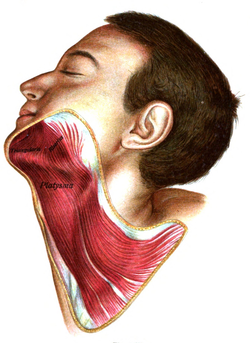Platysma
| Platysma muscle | |
|---|---|

The platysma is visible, with skin removed.
|
|

The muscles of the face, platysma visible at bottom right.
|
|
| Details | |
| Origin | subcutaneous tissue of infraclavicular and supraclavicular regions |
| Insertion | base of mandible; skin of cheek and lower lip; angle of mouth; orbicularis oris |
| Artery | branches of the Submental artery and Suprascapular artery |
| Nerve | Cervical branch of the facial nerve |
| Actions | Draws the corners of the mouth inferiorly and widens it (as in expressions of sadness and fright). Also draws the skin of the neck superiorly when teeth are clenched |
| Antagonist | Masseter, Temporalis |
| Identifiers | |
| Latin | Platysma |
| Dorlands /Elsevier |
p_23/12646241 |
| TA | A04.2.01.001 |
| FMA | 45738 |
|
Anatomical terms of muscle
[]
|
|
The platysma is a muscle that overlaps the sternocleidomastoid.
It is a broad sheet arising from the fascia covering the upper parts of the pectoralis major and deltoid; its fibers cross the clavicle, and proceed obliquely upward and medially along the side of the neck.
Fibres at the front of the muscle from the left and right sides intermingle together below and behind the symphysis menti; the junction where the two lateral halves of the mandible are fused at an early period of life. It is not a true symphysis as there is no cartilage between the two sides of the mandible. Fibres at the back of the muscle cross the mandible, some being inserted into the bone below the oblique line, others into the skin and subcutaneous tissue of the lower part of the face. Many of these fibers blend with the muscles about the angle and lower part of the mouth.
Sometimes fibers can be traced to the zygomaticus, or to the margin of the orbicularis oris. Beneath the platysma, the external jugular vein descends from the angle of the mandible to the clavicle.
Variations occur in the extension over the face and over the clavicle and shoulder; it may be absent or interdigitate with the muscle of the opposite side in front of the neck; attachment to clavicle, mastoid process or occipital bone occurs. A more or less independent fasciculus, the occipitalis minor, may extend from the fascia over the trapezius to fascia over the insertion of the sternocleidomastoideus.
The platysma is supplied by cervical branch of the facial nerve.
...
Wikipedia
